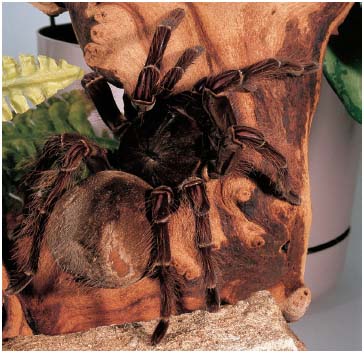Jerry G. Walls - Tarantulas
Here you can read online Jerry G. Walls - Tarantulas full text of the book (entire story) in english for free. Download pdf and epub, get meaning, cover and reviews about this ebook. year: 2009, publisher: CompanionHouse Books, genre: Children. Description of the work, (preface) as well as reviews are available. Best literature library LitArk.com created for fans of good reading and offers a wide selection of genres:
Romance novel
Science fiction
Adventure
Detective
Science
History
Home and family
Prose
Art
Politics
Computer
Non-fiction
Religion
Business
Children
Humor
Choose a favorite category and find really read worthwhile books. Enjoy immersion in the world of imagination, feel the emotions of the characters or learn something new for yourself, make an fascinating discovery.
- Book:Tarantulas
- Author:
- Publisher:CompanionHouse Books
- Genre:
- Year:2009
- Rating:4 / 5
- Favourites:Add to favourites
- Your mark:
- 80
- 1
- 2
- 3
- 4
- 5
Tarantulas: summary, description and annotation
We offer to read an annotation, description, summary or preface (depends on what the author of the book "Tarantulas" wrote himself). If you haven't found the necessary information about the book — write in the comments, we will try to find it.
Tarantulas — read online for free the complete book (whole text) full work
Below is the text of the book, divided by pages. System saving the place of the last page read, allows you to conveniently read the book "Tarantulas" online for free, without having to search again every time where you left off. Put a bookmark, and you can go to the page where you finished reading at any time.
Font size:
Interval:
Bookmark:
Cover and book design concept by Michael Vincent Capozzi Indexed by Kenneth Brace
Cover photo by Zig Leszczynski (front), and James Gerholdt (back).
Illustrations by Thomas Kimball.
The additional photographs in this book are by Isabelle Francais, pp. 5, 14, 17, 20, 40, 43, 53, 63; James Gerholdt, pp. 6, 11, 13, 56, 57, 69, 77, 85, 8789, 91; Paul Freed, 9, 19, 21, 22, 44, 45, 48, 55, 61, 68, 70, 71, 74, 76, 79, 80, 82; Maleta M. Walls, pp. 28, 29, 34, 35, 37, 67; Zig Leszczynski, 72.
Copyright 2005, 2009 by Advanced Vivarium Systems
All rights reserved. No part of this book may be reproduced, stored in a retrieval system, or transmitted in any form or by any means, electronic, mechanical, photocopying, recording, or otherwise, without the prior written permission of Advanced Vivarium Systems, except for the inclusion of brief quotations in an acknowledged review.
LCCN: 96-183295
ISBN: 1-882770-85-4
ISBN 13: 978-188277085-4
eISBN 13: 978-162008026-9

An Imprint of I-5 Press
A Division of I-5 Publishing, LLC
3 Burroughs
Irvine, CA 92618
We want to hear from you. What books would you like to see in the future? Please feel free to write us with any comments on our AVS books.
Printed and bound in Singapore
10 9 8 7 6 5 4 3 2
CONTENTS
CHAPTER 1
GENERAL INFORMATION
T arantulas! The very mention of these large, hairy spiders can bring chills of fear and disgust to many people and of course prompt the question,Why on earth would you want to keep THAT as a pet? The answer is that tarantulas are fascinating spiders that have intrigued naturalists and hobbyists for years, and they actually do very well as household pets.
For more than twenty-five years, the hobby of keeping tarantulas has been growing in numbers and in importance in the United States, Europe, and Japan. Today, it is possible to purchase specimens from about a hundred species from around the world, a quarter of these in the form of captive-bred young. Yet tarantulas still are misunderstood by many pet keepers and sellers; a surprising number, perhaps a quarter of those reaching the wholesaler, die each year from poor caging and from a misunderstanding of their basic needs. If kept properly, tarantulas can be excellent pets that are easy to care for and feed and that may (repeat, may) even breed in their cages.
This book is intended for beginners faced with making an initial purchase of the best tarantulas from a local shop or through the mail, learning how to house them correctly, and perhaps trying to satisfy their curiosity about how tarantulas breed and grow. It is not intended as a discussion of the complexities and uncertainties of tarantula taxonomy, though this subject must be touched upon so the hobbyist gains some idea of what type of tarantula he or she is considering to keep as a pet. It also is not a scientific treatise on tarantula anatomy and biology, though we will cover enough about these subjects in passing to put tarantulas in perspective. In fact, lets start with seeing just where tarantulas fit into the scheme of things and how they are related to other organisms.

Sight of this hairy tarantula crawling up a branch gives many people the creeps! However, tarantulas are in fact quite popular pets in households around the world. With an understanding of their needs, theyre simple to care for and fun to observe.
Where Tarantulas Fit
Tarantulas are simply spidersbig and primitive spiders. They belong to the order Araneae (the spiders) of the phylum Arthropoda (invertebrate animals with jointed legs, including the insects, crustaceans, and even trilobites), and to the class Arachnida, a large assemblage of animals including such diverse groups as the scorpions, solpugids, and mites. Like insects and millipedes (class Insecta [also called class Uniramia] and class Myriopoda), they have jointed legs (four pairs in this case), but they dont have antennae (insects, millipedes, and centipedes have a single pair). The arachnids are among the most distinctive living invertebrates and have been around for hundreds of millions of years.
Spiders are themselves a group of at least thirty-five thousand species of minute to small invertebrates whose bodies are divided into just two parts: a large cephalothorax or prosoma comprising the head, mouthparts, and eyes, as well as the muscles that work the legs; and a generally rounded abdomen or opisthosoma that contains reproductive organs, breathing organs, the heart, kidneylike organs, and the silk glands, as well as a major part of the digestive organs. The cephalothorax and abdomen are connected by a short, narrow tubecalled the pedicelthrough which pass the gut, blood sinuses, and nerves. Spiders are found virtually everywhere. There are probably at least a dozen species lurking around your kitchen right now, as well as another fifty species in your flower garden. Arachnologists divide the spiders into about one hundred smaller groups of closely related species; these groups are called families. Of these, about 15 percent comprise the primitive forms known all together as tarantulas and their allies, suborder Mygalomorphae.

In this close-up shot of a Costa Rican striped-knee (also called a zebra) tarantula, we can see the two large, hairy chelicerae.
Tarantulas overall are medium-sized, generally smooth spiders that have two large, projecting jaws called chelicerae (singular, chelicera), each ending in a slightly curved fang that is used to inject venom into the prey. The fang rotates up and down parallel to the center axis or plane of the body, whereas in most other spiders (advanced spiders, suborder Araneomorphae) the fangs are angled so when opened they are oblique or even perpendicular to the axis of the body. There is some indirect evidence that tarantulas were around as far back as four hundred million years, even before insects learned to fly.
Of the fifteen tarantula families, about half build tubular burrows capped with a door of thickened silk that can be rotated to allow the spider to reach out and grab passing prey. These trapdoor tarantulas often have a row of teeth (the rastellum) on the chelicerae that helps them dig their burrows. Most are small and are seldom seen, though some can be collected in the eastern United States as far north as Connecticut. A few species of the families Ctenizidae and Idiopidae are large enough to interest hobbyists.
The remaining families of tarantulas include generally small, smooth species with a variety of habits, but in the pet trade only the members of the family Theraphosidae (known as theraphosids)the true or hairy tarantulas or bird spidersare of great interest to pet keepers. Once called family Avicularidae, these generally are large spiders, commonly 1 1/2 to 4 inches (3.8 to 10 centimeters) long, with projecting chelicerae, a rounded abdomen, and long hairs or bristles of many types on the legs and usually on the abdomen. Most true tarantulas burrow into the substrate or hide during the day under a shelter, but a few species are arboreal (tree-dwelling), building large masses of webs on trees and shrubs. For years literature has said that there are about eight hundred species of true tarantulas, but certainly by now the number must be closer to nine hundred, with perhaps several hundred more still to be defined by scientists. At least one hundred species appear in the hobby on occasion, but only twenty-five or fewer species form the core of the hobbythe species that are readily available to general hobbyists and beginners, that may be somewhat colorful or have distinctive behavior, and that can be kept with relative ease.
Next pageFont size:
Interval:
Bookmark:
Similar books «Tarantulas»
Look at similar books to Tarantulas. We have selected literature similar in name and meaning in the hope of providing readers with more options to find new, interesting, not yet read works.
Discussion, reviews of the book Tarantulas and just readers' own opinions. Leave your comments, write what you think about the work, its meaning or the main characters. Specify what exactly you liked and what you didn't like, and why you think so.










